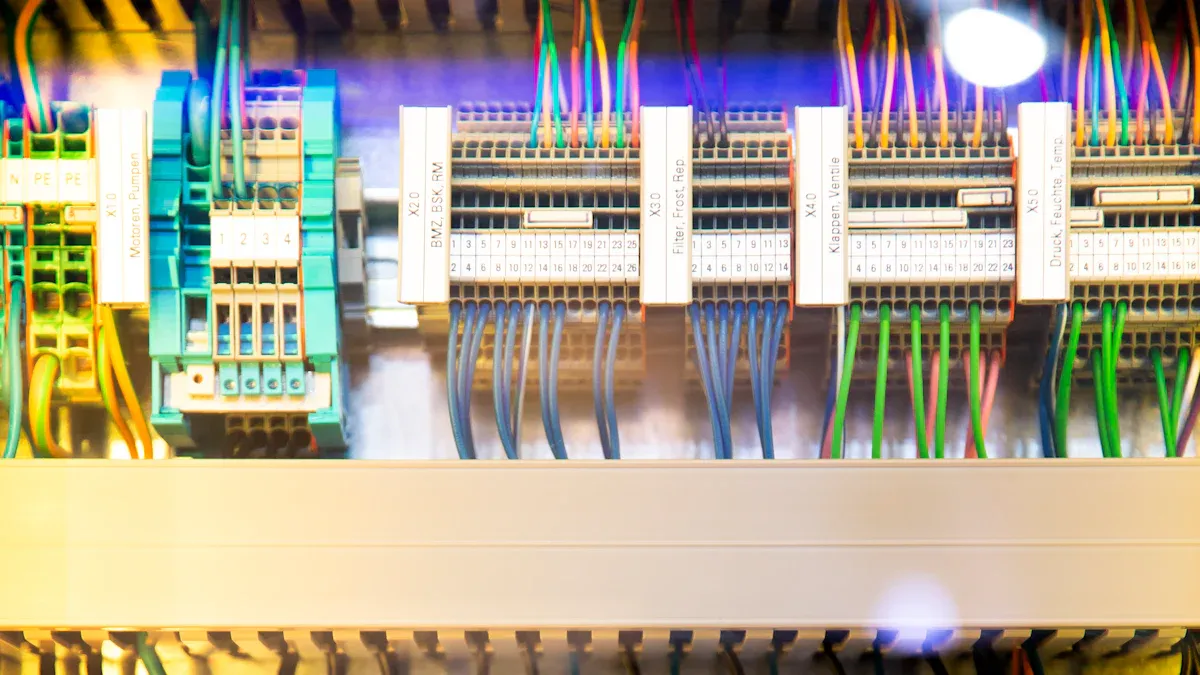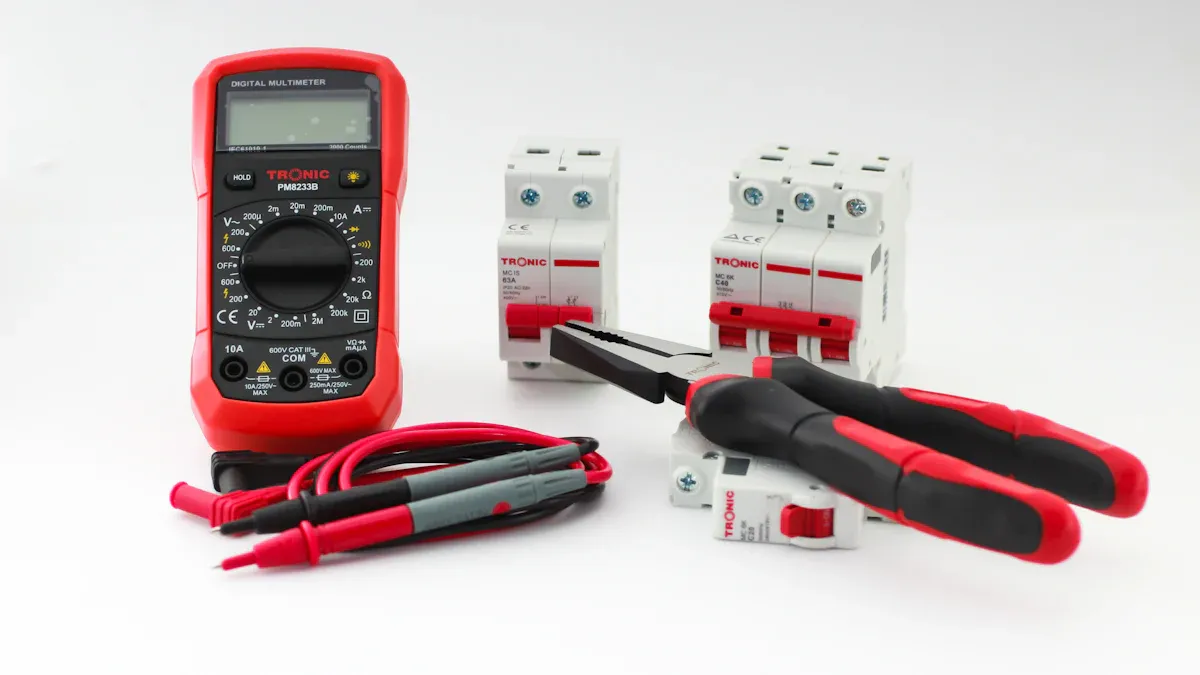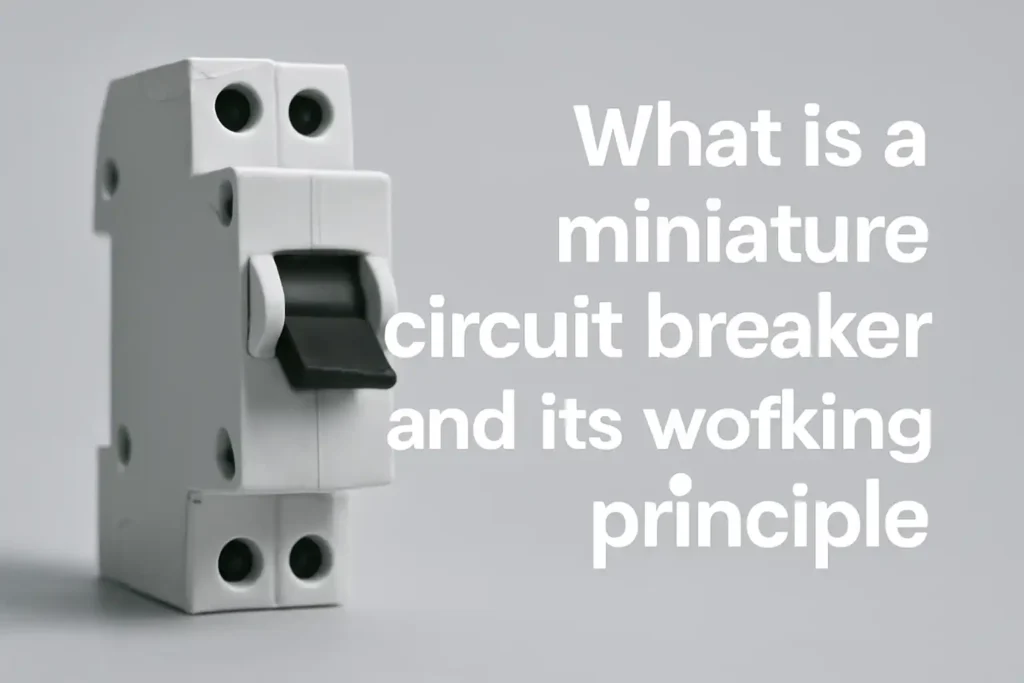A miniature circuit breaker works by using a thermal-magnetic tripping mechanism to automatically disconnect a circuit during overloads or short circuits. You gain protection from electrical fires and equipment damage because the device senses abnormal current and reacts instantly. Recent studies show that many people do not understand their home’s electrical panel, yet these panels, with circuit breakers inside, are essential for safety. As cities and industries grow, the need for reliable automatic circuit protection continues to rise.
Key Takeaways
- Miniature circuit breakers protect electrical circuits by automatically switching off power during overloads or short circuits, preventing fires and damage.
- They use two main tripping methods: a thermal bimetallic strip for slow overloads and a magnetic solenoid coil for instant short circuit protection.
- MCBs are resettable and more convenient than fuses, saving time and money by avoiding replacements after trips.
- Choosing the right MCB involves matching voltage, current, trip curve, and application type to your electrical system for safe and reliable operation.
- Regular maintenance, including yearly testing and inspection, keeps MCBs working well and ensures ongoing electrical safety.
What Is a Miniature Circuit Breaker
Definition
You may see a miniature circuit breaker in your home’s electrical panel, but what does it actually do? A miniature circuit breaker is a small device that protects electrical circuits from damage. It works by sensing when too much current flows through a circuit and then quickly disconnects the power to prevent hazards. You can find these devices in homes, offices, and factories because they keep people and equipment safe.
Here is a quick overview:
| Aspect | Description |
|---|---|
| Definition | Miniature circuit breakers are small electromechanical devices designed to protect electrical circuits from overcurrent failures, ensuring safety in residential, commercial, and industrial settings. |
| Functional Role | They automatically open and close circuits during overloads or short circuits, replacing fuses by providing resettable protection without replacement. |
| Tripping Mechanisms | 1. Thermal Tripping: Uses a bimetallic strip that bends with heat from overload current to trip the breaker with a delay. 2. Magnetic Tripping: Uses an electromagnetic device that trips instantly during short circuits. |
| Relevant IEC Standards | IEC 60947-2 (industrial use), IEC 60898-1 (household use) |
Main Function
You rely on a miniature circuit breaker to keep your electrical system safe. Its main function is to protect circuits from two main dangers: overloads and short circuits. When you plug in too many devices or a fault occurs, the breaker senses the extra current. It then trips, or switches off, to stop the flow of electricity. This action prevents wires from overheating and reduces the risk of fire.
Tip: Unlike fuses, you can reset a miniature circuit breaker after it trips. You do not need to replace any parts, which makes it more convenient and reliable.
Key characteristics of miniature circuit breakers include:
- Protection against overloads and short circuits by automatically switching off circuits when faults are detected.
- Dual tripping mechanisms: a delayed thermal trip for overloads and a fast magnetic trip for short circuits.
- Compliance with global standards such as IEC, UL, and CSA.
- Available in different trip curves (B, C, D, K, Z) to match various applications.
- Breaking capacities up to 25 kA and rated currents up to 100 A.
- Multiple configurations for different electrical installations.
You can trust a miniature circuit breaker to act as a smart guard for your electrical system, keeping your home or workplace safe from electrical hazards.
Miniature Circuit Breaker Structure

Key Components
You can find several important parts inside a miniature circuit breaker. Each part has a special job to keep your electrical system safe. According to technical sources like the Wikipedia article on circuit breakers, these are the main components you will see:
- Actuator lever – lets you manually turn the breaker on or off and shows its status.
- Actuator mechanism – moves the contacts together or apart.
- Contacts – carry current when closed and stop current when open.
- Terminals – connect the breaker to your wiring.
- Bimetallic strip – senses heat from too much current.
- Calibration screw – adjusts the trip current.
- Solenoid – reacts quickly to high current.
- Arc divider/extinguisher – puts out the arc when the breaker trips.
You can also find these parts described in technical manuals and guides. These sources explain that the housing is made from heat-resistant materials to protect the inside parts. The modular design makes it easy to install or replace a miniature circuit breaker in your panel.
Bimetallic Strip
The bimetallic strip is a key part of the thermal trip unit. When too much current flows for a long time, the strip heats up and bends. This bending action pushes the contacts apart and breaks the circuit. Engineering studies show that experts use special tests to measure how the strip bends and how fast it reacts to heat. They use tools like high-speed cameras and infrared sensors to check the temperature and movement. These tests help make sure the bimetallic strip works well and meets safety standards.
Note: The bimetallic strip protects your wiring from overheating by reacting to slow, steady overloads.
Solenoid Coil
The solenoid coil is the heart of the magnetic trip unit. When a short circuit happens, a large current flows through the coil. This creates a strong magnetic field that moves a metal plunger or lever. The movement quickly opens the contacts and stops the current. The solenoid coil acts much faster than the bimetallic strip. It protects your system from sudden, dangerous faults. Technical guides explain that the solenoid coil works with other parts to make sure the miniature circuit breaker trips instantly during a fault.
- The solenoid coil generates a magnetic field based on the current.
- It moves mechanical parts to open the breaker quickly.
- It works together with the bimetallic strip for full protection.
Working Principle

When you use a miniature circuit breaker, you trust it to protect your electrical system. The device works by using two main tripping mechanisms: thermal tripping and magnetic tripping. Each method responds to different types of electrical faults. You also benefit from special features that safely interrupt the current and put out dangerous arcs.
Thermal Tripping
Thermal tripping protects you from slow, steady overloads. Inside the miniature circuit breaker, you find a bimetallic strip. When too much current flows for a long time, the strip heats up. The heat causes the strip to bend. As it bends, it pushes a lever that opens the contacts. This action breaks the circuit and stops the flow of electricity.
You can think of the bimetallic strip as a safety guard. It reacts to extra heat from overloaded wires. If you plug in too many devices, the strip senses the danger and trips the breaker. This process takes a few seconds or minutes, depending on the amount of overload. The delay helps prevent nuisance tripping from small, harmless surges.
Tip: The bimetallic strip only trips when the overload lasts long enough to cause real danger. Short bursts of high current, like when you start a vacuum cleaner, usually do not trip the breaker.
Magnetic Tripping
Magnetic tripping protects you from sudden, dangerous faults like short circuits. In this part of the miniature circuit breaker, you find a solenoid coil. When a very high current flows, the coil creates a strong magnetic field. This field pulls a metal plunger or lever. The movement instantly opens the contacts and stops the current.
Recent test results show that the magnetic tripping part works very quickly and reliably. For example, a tested breaker with an adjustable trip point between 400 and 600 amps trips within one cycle (about 17 milliseconds) when the current reaches 400 amps or more. The breaker uses a blow-apart contact design. As the current rises, the magnetic field gets stronger and forces the contacts apart even faster. Experts confirm this performance using special tests that follow strict standards. You can trust the magnetic tripping mechanism to protect your home or workplace from sudden electrical faults.
- The solenoid coil reacts almost instantly to high fault currents.
- The magnetic field moves the contacts apart to break the circuit.
- This fast action prevents damage to wires and connected devices.
Air-Break and Arc Extinguishing
When the contacts inside a miniature circuit breaker open, a bright electric arc forms. This arc can be very hot and dangerous. The breaker uses an air-break principle to help put out the arc quickly. As the contacts separate, air rushes in and cools the arc. The breaker also has an arc runner and arc chute. These parts guide the arc into a special chamber with metal plates.
The arc chute splits the arc into smaller pieces. Each piece loses energy and cools down faster. The metal plates absorb heat and help put out the arc. This process protects the breaker and your wiring from damage. You stay safe because the breaker interrupts the current without letting the arc cause harm.
Note: The air-break and arc extinguishing system makes sure the breaker can safely stop even large fault currents.
You now understand how a miniature circuit breaker uses thermal and magnetic tripping, along with air-break and arc extinguishing, to keep your electrical system safe.
MCB vs Fuses
Differences
You may wonder how MCBs and fuses differ in protecting your electrical circuits. The main difference comes from how each device reacts to too much current. Fuses use a thin metal strip that melts when the current gets too high. This action breaks the circuit almost instantly, usually within 2 milliseconds during a short circuit. However, once a fuse blows, you must replace it before your circuit works again.
MCBs, on the other hand, use a mechanical system. Inside, you find a magnetic solenoid and a bimetallic strip. When the current rises quickly, the magnetic part trips the breaker. If the current stays high for a longer time, the bimetallic strip bends and trips the breaker. This process takes about 20 milliseconds, which is a bit slower than a fuse. The big advantage is that you can reset an MCB with a simple switch, so you do not need to buy new parts after every trip.
| Feature | Fuse | MCB |
|---|---|---|
| Reaction Time | Very fast (2 ms) | Fast (20 ms) |
| Resettable | No, must replace | Yes, just reset |
| Mechanism | Melting metal strip | Electromechanical (thermal + magnetic) |
| Maintenance | Needs replacement | Minimal, just reset |
| Cost | Lower upfront | Higher upfront, lower over time |
Note: Fuses are simple and cost less at first, but MCBs save you time and money in the long run.
Advantages
You gain several benefits when you choose MCBs over fuses. First, MCBs offer easy and quick resetting. You do not need to handle wires or buy new parts after a trip. This feature reduces downtime and keeps your system running smoothly. MCBs also provide better safety because all connections stay enclosed inside the breaker box.
Recent market data shows that circuit breakers, including MCBs, now hold nearly 79% of the market share. This strong preference comes from their reliability, safety, and convenience. MCBs protect against both overloads and short circuits, making them suitable for homes, offices, and factories. As technology advances, smart MCBs and compact designs make them even more attractive.
- You can reset MCBs quickly after a fault.
- MCBs reduce fire risks by keeping all parts enclosed.
- They work well in many settings, from homes to large industries.
- MCBs lower operational costs and downtime.
Tip: If you want a safer and more reliable electrical system, MCBs give you flexibility and peace of mind.
Choosing an MCB
Selection Tips
You want to pick the right circuit breaker for your needs. Start by checking the voltage and current ratings. These numbers must match your system to prevent overheating or false trips. Look at the type of load in your circuit. For example, use Type B for lights and small appliances, Type C for motors, and Type D for heavy machines.
You should also consider the number of poles. Single-pole breakers work for most homes. Multi-pole breakers fit three-phase or complex systems. Think about the environment. High temperatures, dust, or moisture can affect performance. Always choose breakers that meet safety standards like UL or CSA.
Here is a helpful table to guide your selection:
| Attribute | Selection Guidance |
|---|---|
| Ampere Rating (A) | Match to your load (6A, 10A, 16A, 20A, 25A, 32A) |
| Voltage Rating (V) | Match your system (120V, 240V, 415V) |
| Number of Poles | 1P for single-phase, 2P/3P/4P for three-phase or neutral protection |
| Breaking Capacity | Choose for your system’s short-circuit risk (6kA, 10kA, 16kA) |
| Trip Curve Type | B for resistive, C for inductive, D for heavy machinery, K for motors, Z for sensitive electronics |
| Frequency | Match system (50Hz or 60Hz) |
| Application Type | Residential, commercial, or industrial |
| Additional Features | Lockouts, indicators, remote control, arc fault protection |
Tip: Always check compatibility with your existing equipment before buying a new breaker.
Maintenance
You keep your electrical system safe by maintaining your breakers. Exercise each breaker at least once a year. Move the handle on and off five times. This action keeps the parts working and cleans the contacts. Listen for a single snap when you operate the handle. If you hear uneven sounds, the breaker may need service.
Inspect the breaker for damage, loose connections, or signs of overheating. Check the housing, terminals, and arc chute. Clean dust and dirt using safe methods. Always turn off power before you start maintenance. Wear proper safety gear if you work near live parts.
Follow these best practices:
- Only let trained people perform maintenance.
- De-energize all circuits before testing or repairs.
- Keep records of inspections and tests.
- Check for moisture or corrosion, especially outdoors.
- Make sure all labels and settings match your system.
Note: Regular maintenance helps your breakers last longer and keeps your home or business safe.
You depend on a miniature circuit breaker to keep your home or business safe from electrical hazards. Modern designs now include features like arc extinguishing, remote control, and real-time monitoring. These improvements make your electrical system safer and more reliable. Devices such as RCCBs add extra protection by quickly detecting faults and stopping dangerous currents. When you choose and maintain the right breaker, you help prevent fires and shocks. Always match the breaker to your needs and check it regularly.
FAQ
What happens if you reset an MCB too often?
Resetting an MCB many times can wear out its internal parts. You should check for the cause of repeated trips. Fix the problem before you reset the breaker again. This helps keep your electrical system safe.
Can you use an MCB for both AC and DC circuits?
Some MCBs work for both AC and DC circuits. Always check the label or datasheet. Using the wrong type can cause the breaker to fail. You should pick the right MCB for your system.
Why does your MCB trip when you turn on an appliance?
Your MCB trips because the appliance may draw too much current or have a fault. You should unplug the device and try again. If the breaker trips again, call an electrician to check for problems.
How do you know if your MCB is faulty?
If your MCB trips with no load or will not reset, it may be faulty. You might also see burn marks or smell burning. Replace the breaker or call a professional for help.
Do MCBs need regular testing?
You should test your MCBs once a year. Turn them off and on a few times to keep them working well. Regular checks help you find problems early and keep your system safe.
The following may be of interest to you
The difference between AC MCB and DC MCB
The difference between MCCB and MCB
How to Calculate the Load Capacity of a 32 Amp MCB



